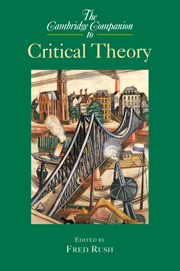15 results
Chapter 2 - Don Giovanni and the Musical-Erotic
-
-
- Book:
- Kierkegaard's <i>Either/Or</i>
- Published online:
- 16 November 2023
- Print publication:
- 30 November 2023, pp 25-41
-
- Chapter
- Export citation
David Graeber and David Wengrow: The Dawn of Everything: A New History of Humanity. (New York: Farrar, Straus, Giroux, 2021. Pp. xii, 692.)
-
- Journal:
- The Review of Politics / Volume 84 / Issue 4 / Fall 2022
- Published online by Cambridge University Press:
- 06 September 2022, pp. 630-634
-
- Article
- Export citation
3 - Hermeneutics and Romanticism
-
-
- Book:
- The Cambridge Companion to Hermeneutics
- Published online:
- 27 December 2018
- Print publication:
- 03 January 2019, pp 65-86
-
- Chapter
- Export citation
46 - The Frankfurt School
-
-
- Book:
- The Cambridge History of Moral Philosophy
- Published online:
- 13 December 2017
- Print publication:
- 07 December 2017, pp 607-622
-
- Chapter
- Export citation
Diabolus in dialectica
-
- Journal:
- Hegel Bulletin / Volume 38 / Issue 2 / October 2017
- Published online by Cambridge University Press:
- 16 January 2017, pp. 221-240
- Print publication:
- October 2017
-
- Article
- Export citation
Notes on contributors
-
-
- Book:
- Interpreting Schelling
- Published online:
- 05 October 2014
- Print publication:
- 29 September 2014, pp vii-ix
-
- Chapter
- Export citation
Chapter 11 - Schelling’s critique of Hegel
-
-
- Book:
- Interpreting Schelling
- Published online:
- 05 October 2014
- Print publication:
- 29 September 2014, pp 216-237
-
- Chapter
- Export citation
8 - ‘Rationalisation’, ‘reification’, ‘instrumental reason’
-
-
- Book:
- The Impact of Idealism
- Published online:
- 05 December 2013
- Print publication:
- 21 November 2013, pp 186-207
-
- Chapter
- Export citation
Hegel, Humour, and the Ends of Art
-
- Journal:
- Bulletin of the Hegel Society of Great Britain / Volume 31 / Issue 2 / Autumn/Winter 2010
- Published online by Cambridge University Press:
- 22 April 2013, pp. 1-22
- Print publication:
- Autumn/Winter 2010
-
- Article
- Export citation

The Cambridge Companion to Critical Theory
-
- Published online:
- 28 May 2006
- Print publication:
- 26 August 2004
1 - Conceptual foundations of early Critical Theory
-
-
- Book:
- The Cambridge Companion to Critical Theory
- Published online:
- 28 May 2006
- Print publication:
- 26 August 2004, pp 6-39
-
- Chapter
- Export citation
Frontmatter
-
- Book:
- The Cambridge Companion to Critical Theory
- Published online:
- 28 May 2006
- Print publication:
- 26 August 2004, pp i-xx
-
- Chapter
- Export citation
Select bibliography
-
- Book:
- The Cambridge Companion to Critical Theory
- Published online:
- 28 May 2006
- Print publication:
- 26 August 2004, pp 361-370
-
- Chapter
- Export citation
Index
-
- Book:
- The Cambridge Companion to Critical Theory
- Published online:
- 28 May 2006
- Print publication:
- 26 August 2004, pp 371-376
-
- Chapter
- Export citation
Introduction
-
-
- Book:
- The Cambridge Companion to Critical Theory
- Published online:
- 28 May 2006
- Print publication:
- 26 August 2004, pp 1-5
-
- Chapter
- Export citation



